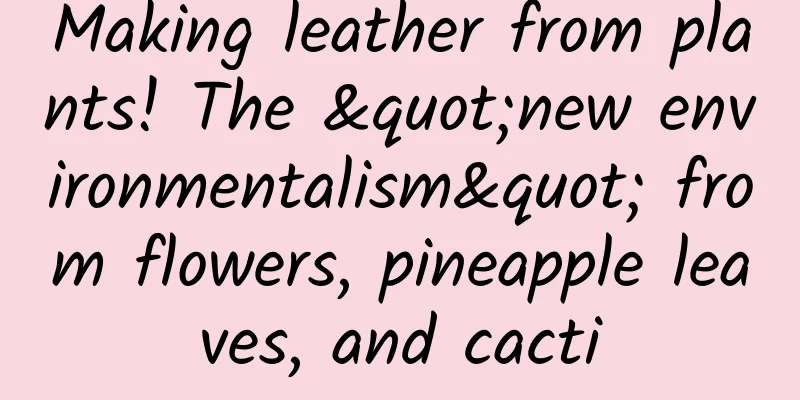Making leather from plants! The "new environmentalism" from flowers, pineapple leaves, and cacti

|
You will never guess what the leather in this picture is made of - It looks like alligator leather, or faux leather that mimics alligator leather, but it's actually made from flowers and fungi. An Indian company turns discarded flowers into "plant leather" for use in wallets, sneakers and other products. Ankit Agarwal, the founder of the company, said he hopes to make animal leather a thing of the past. Had they not been made into vegetable leather, the flowers would have been thrown into the Ganges. In India, many temples offer marigolds, roses, chrysanthemums, etc. They are used in religious ceremonies and are considered sacred, but this makes the disposal of discarded flowers a problem. Sacred flowers cannot be disposed of with other garbage, and believers and temples usually dump them into the Ganges, the most sacred river in the hearts of Hindus. But an average temple can produce hundreds of kilograms of discarded flowers a day, and eventually tons of flowers become garbage in the Ganges. The pesticides contained in the flowers release toxic chemicals, polluting the water of the Ganges. It was after witnessing the scene of garbage floating on the Ganges that Ankit Agarwal founded a company in 2017 to explore ways to reuse discarded flowers. He named the company Phool, which means "flower" in Hindi. Ankit Agarwal's original idea was not to make leather, but to make incense sticks. Every morning, they would go to the temples in Kanpur to collect discarded flowers, pick the petals, dry them, grind them into powder, add essential oils, and finally make incense sticks. Not long after, they unexpectedly discovered that on humid days, a layer of white substance appeared on the pile of discarded flowers. This should be some kind of fungal microorganism that draws nutrients from the cellulose of the flowers to form a fiber network. Driven by curiosity, they adjusted the strain, temperature and humidity, and eventually let the microorganisms produce a material on the flowers that looks like foam plastic and can be used for packaging - even more amazingly, this material feels like leather. After continuous adjustments and improvements, Phool began to produce this plant leather in 2021. They use nutrient-rich flower fluid to cultivate fungal microorganisms, allowing the fungi to grow rapidly and form a fiber layer; then, they use a solution made from bark powder to tan the microbial fiber layer, and after drying and dyeing, it can become usable plant leather. In order to make it more realistic, they also press snake skin or crocodile skin patterns on the plant leather, which is said to feel very similar to real leather. This plant leather is named Fleather, which is a combination of the first letters of "Flower" and "leather". Currently, Fleather has been made into wallets, shoulder bags, sandals, sneakers and other products. In 2022, Fleather won the Earthshot Prize for its commitment to creating a waste-free world. Phool is not the only company developing plant-based leather. In the past two years, many fashion companies have emphasized environmental awareness, and exploring alternatives to animal leather is one of the directions the fashion industry is trying. The controversy over animal leather has a long history. On the one hand, in the past, people's pursuit of animal fur has led to a sharp decline in the population of many species. On the other hand, even the production process of common calfskin and goat skin will bring environmental problems - a large amount of greenhouse gases will be produced during the breeding process, and the process of making and processing leather will release heavy metals and pollute water bodies. Since the 20th century, people have begun to develop and use artificial leather. Artificial leather is mostly made of plastic, and its production and degradation process will also cause pollution. Plant leather is much more environmentally friendly. The wastewater and waste gas discharged during its production process are 35% lower than those of artificial leather. It can also be biodegraded after being discarded. Many companies have launched plant leather products. Nike has launched sneakers made of pineapple leaf leather. It is said that the fibers obtained by removing the gelatin from pineapple leaves are soft and breathable, and pineapple leather can be obtained after waxing and pressing. H&M has made leather jackets with pineapple leaf leather, and has also used orange peel fibers to weave silk-like fabrics and added algae to woven sandals. A Mexican company has launched "cactus leather", which is made into handbags, leather shoes, clothing and car seats, and is estimated to be usable for 10 years. In addition, there is "mushroom leather", which is a bit like Fleather - mushroom hyphae grow to form a fiber network, and then this network result is processed. Hermès has launched handbags with mushroom leather, Stella McCartney has used it as a raw material to make bras and leather pants, and sports brands Adidas and Lululemon have also launched mushroom leather sports shoes and yoga mats respectively. Unfortunately, these plant-based leather products have not yet been widely marketed - they are not perfect yet. From an environmental perspective, although plant leather itself is biodegradable, it is often necessary to use non-biodegradable adhesives to make it into products. Fortunately, more and more companies are researching pure plant materials, which makes it possible for plant leather products to be 100% biodegradable. Phool claims that the Fleather they produce can be completely degraded in 90 days as long as it is buried in the soil. However, if Fleather is to be promoted in large quantities in the market, it needs to solve the problems of production and quality. Currently, Phool can produce about 840 square meters of Fleather leather every month, which is only enough to produce 2,250 wallets; the maximum area of a single piece of leather produced is only 0.8 square meters. If the production is not enough, it will be difficult to truly enter the consumer market. In terms of quality, the biggest issues are strength and durability. The tensile strength of traditional leather is 8-25 MPa, but Fleather is only 6-10 MPa, which means it is not currently suitable for products with high load-bearing requirements. Moreover, the strength is not ideal, and the durability of plant leather is also questionable - especially compared to genuine leather, which can be used for decades if properly preserved, the service life of plant leather is currently much shorter. But Ankit Agarwal is not worried. He believes that as long as the last 10% of the work is completed and the tensile strength is improved, Fleather can be brought to the market and bring changes to the world. We cannot draw a conclusion yet whether animal leather can be replaced by plant leather as he hopes. After all, it is not only about whether the two types of leather materials are easy to use, but also about people's long-established consumption concepts. However, the emergence of environmentally friendly leathers such as Fleather, pineapple leaf leather, cactus leather, and mushroom leather has given consumers more choices and made more people aware of the environmental problems behind traditional leather. Finally, although you can’t buy plant leather right away, as an ordinary consumer, there are already many things you can do, such as: Perhaps in the near future, environmental protection can really become a fashion. References: [1] Pathak, S. (2022, December 20). The vegan leather made from India's waste flowers. BBC Future. https://www.bbc.com/future/article/20221208-fleather-the-vegan-leather-made-of-indias-flower-waste [2] The Earthshot Prize. (2022, November 8). Fleather - The Earthshot Prize. https://earthshotprize.org/winners-finalists/fleather/ [3] Vijayaraghavan, V. (2021, November 26). Plant Based Leather: Green Is the New Black When It Comes to Vegan Leather. Nomomente Institute. https://www.nomomente.org/post/plant-based-leather |
Recommend
How to attract 600 million low-end users?
In 2019, the concept of sinking markets was extre...
Xiaohongshu Food Popularity Article Methodology
The article starts with analyzing the hot food ar...
Creative analysis of educational and training advertising materials!
According to QuestMobile data, the online educati...
7 B2B content marketing trends for 2019!
With its unparalleled efficiency and considerable...
Tesla blames State Grid for new car failure, official apology: recording edited
On February 1, Tesla officially issued an apology...
How to debug Android Framework?
Linus has a famous saying that is widely known: R...
Feeling guilty about eating, drinking and having fun during the Spring Festival? Then you need to learn these methods urgently
Drinking too much, playing cards, and staying up ...
Observation on Brazil's new energy vehicle industry: small scale but fast growth, Chinese manufacturers have an absolute advantage
In the past few years, the global new energy vehi...
Analysis of the planning process of "Learn Together" online course activities
Figure 1-Case analysis mind map 1. User Path User...
Qin Jiabo Baidu Domination SEO, the original Domination SEO Six Swords Heart Method, each transaction is several thousand yuan
Original: Baidu's Six Swords of Screen Domina...
How does bidding reduce costs? Bidding promotion method to reduce costs!
Some time ago, someone asked the editor in the gr...
Why do middle-aged men love fishing so much?
From being able to dig holes anywhere as boys, to...
How can Weibo advertising take advantage of the epidemic to revive?
“If you were given a room with a suitable tempera...
Migratory locusts: They can run marathons and also love to race 100 meters
Do you remember the global locust plague in early...
How to let content operations penetrate products and drive rapid product growth
"Content" in a broad sense includes mus...









